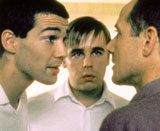Arts John Travolta's Aggressive Suckery
posted by on June 15 at 9:14 AM

When I first heard that the new movie musical of Hairspray would star John Travolta as Edna Turnblad (originated on film by the brilliant Divine and reprised in the musical by a Tony-winning Harvey Feirstein), I did more than reserve judgment--I actively hoped Travolta was harboring some untapped camp talent that would make the casting make sense and perhaps result in triumph. It seemed possible: Why would John Travolta want to do something he's horrible at?
Who knows, but judging from this preview clip, he does, and has, and it ain't pretty. As Defamer notes, "The scene prominently features Travolta's Edna Turnblad delivering her dialogue in an utterly inscrutable Southern-ish accent (doesn't it take place in Baltimore?) in a register slightly deeper than Travolta's own."
As for "untapped camp talent," Travolta displays none. I'm tempted to say, "This is the kind of drag your dad would do," but it's too weird. One thing's for sure: Travolta's never seemed straighter. Weird.
(However, I remain excited to see Alison Janney's take on the spastic-with-racism Mrs. Pingleton.)

 I bring this up on the Slog today because I learned last Friday that the idea had never occurred to our very own Star Wars expert, Jonah Spangenthal-Lee. But at the bottom of all that is in and about Star Wars is junk. The leading motive of the movie is junk: what to do with it, how to get rid of it, and how you can be confused with and crushed by it. The Millennium Falcon is a piece of junk, a whole race of little Arab-like people survive by selling junk on desert planets, and robots have only two conditions: being junk and being not junk.
I bring this up on the Slog today because I learned last Friday that the idea had never occurred to our very own Star Wars expert, Jonah Spangenthal-Lee. But at the bottom of all that is in and about Star Wars is junk. The leading motive of the movie is junk: what to do with it, how to get rid of it, and how you can be confused with and crushed by it. The Millennium Falcon is a piece of junk, a whole race of little Arab-like people survive by selling junk on desert planets, and robots have only two conditions: being junk and being not junk.  This is the situation in the movie The Constant Gardener. Tessa Quayle (Rachel Weisz) works with Dr. Joshua Ngaba ( Jon Sibi Okumu) in the slums of Nairobi. Tessa Quayle is English (Wiesz is Jewish), and married to Justin Quayle (Ralph Fiennes), an Englishman (Fiennes is English). Justin works for the British Embassy and almost never sees his wife; not he but she is too busy at her work, too busy trying to save the world in the slums of Nairobi.
This is the situation in the movie The Constant Gardener. Tessa Quayle (Rachel Weisz) works with Dr. Joshua Ngaba ( Jon Sibi Okumu) in the slums of Nairobi. Tessa Quayle is English (Wiesz is Jewish), and married to Justin Quayle (Ralph Fiennes), an Englishman (Fiennes is English). Justin works for the British Embassy and almost never sees his wife; not he but she is too busy at her work, too busy trying to save the world in the slums of Nairobi.



























 What is Blood Diamond about? Not Africa, of course, nor about the evils of globalization, but about the maintenance of American middle-class values in the storm of the public's growing awareness about the evils of globalization.
What is Blood Diamond about? Not Africa, of course, nor about the evils of globalization, but about the maintenance of American middle-class values in the storm of the public's growing awareness about the evils of globalization. 


